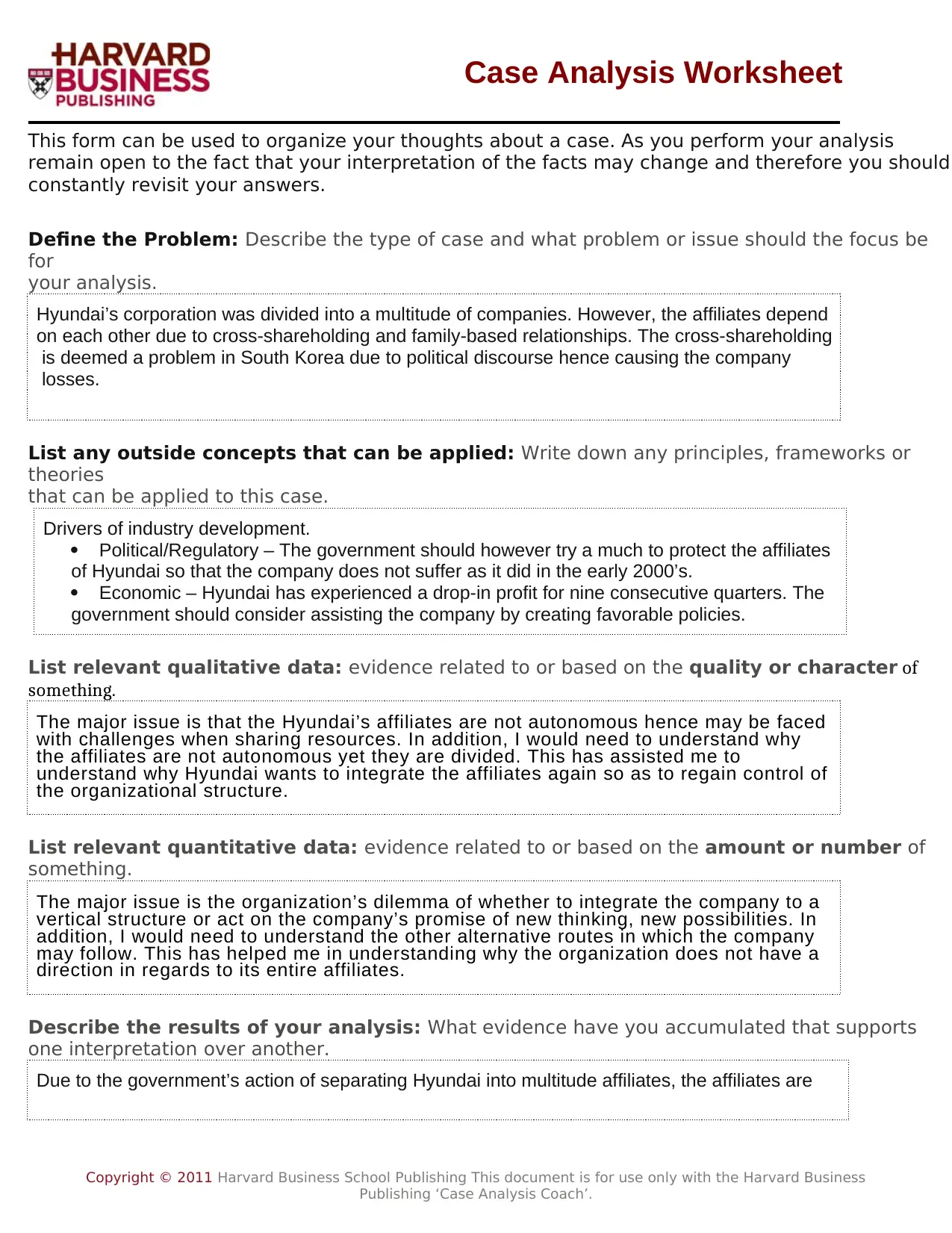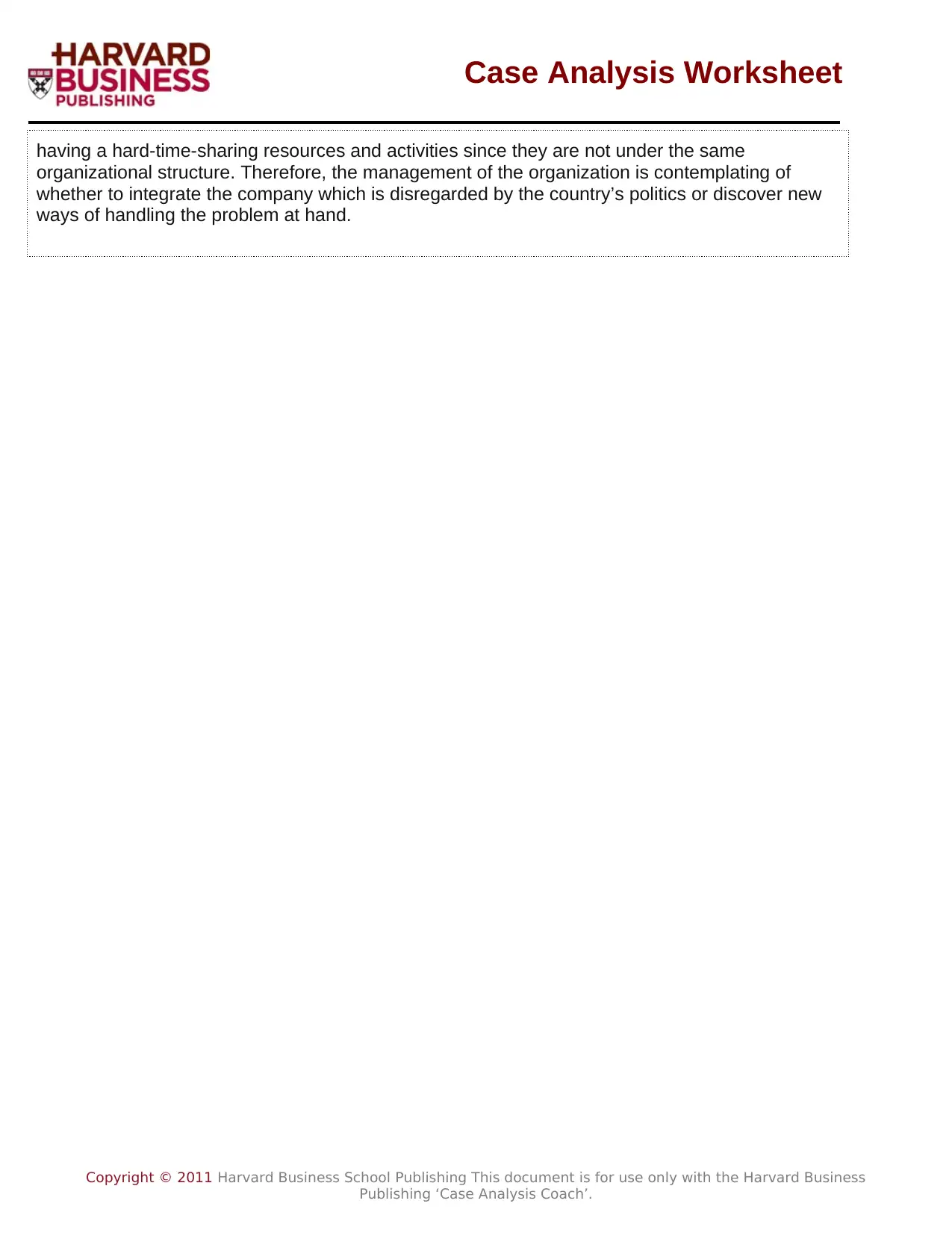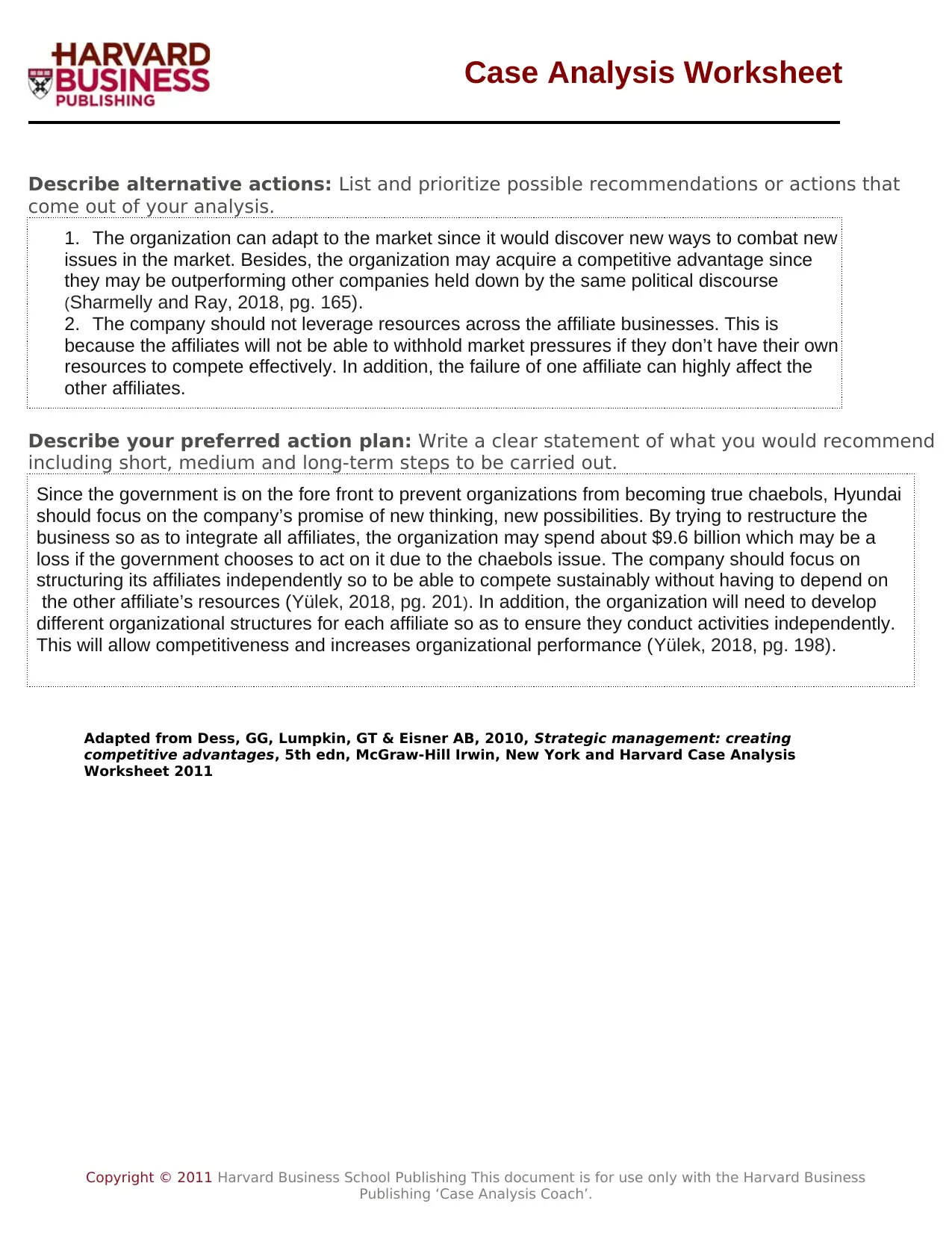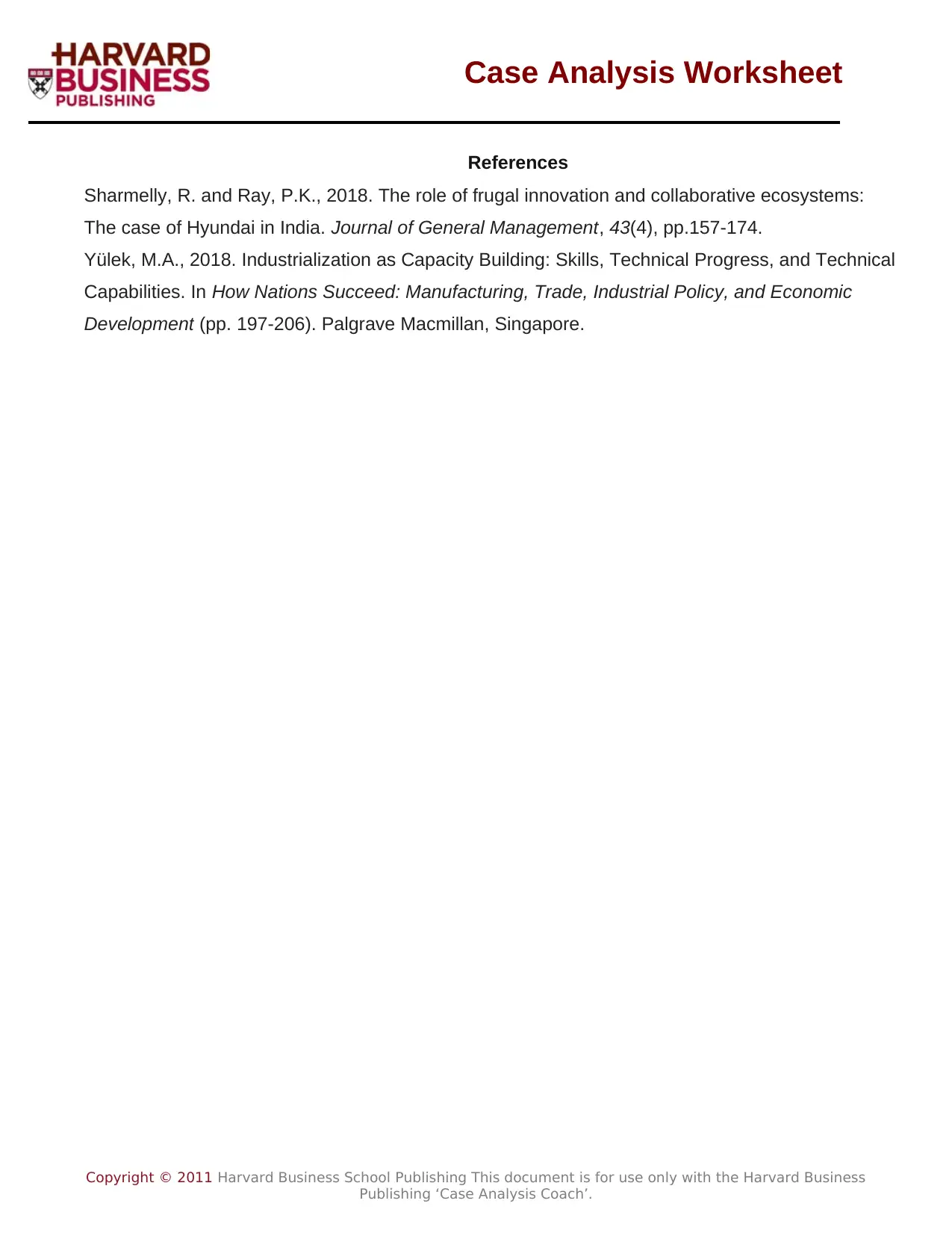Business Development: Hyundai Corporation Case Analysis
VerifiedAdded on 2023/06/05
|4
|997
|315
Case Study
AI Summary
This case analysis examines the challenges faced by Hyundai Corporation, focusing on the impact of cross-shareholding and political discourse in South Korea. The analysis identifies the core problem as the dependence of Hyundai's affiliates on each other, leading to potential losses and resource sharing issues. It applies concepts like drivers of industry development and analyzes qualitative and quantitative data to understand the organization's dilemma of whether to integrate or restructure. The analysis suggests that, given the government's stance against chaebols, Hyundai should focus on independent affiliate structures to foster competitiveness and sustainable performance. The recommended action plan involves developing distinct organizational structures for each affiliate to promote independent operations and enhance overall organizational performance. The analysis references relevant literature to support its conclusions.

Case Analysis Worksheet
This form can be used to organize your thoughts about a case. As you perform your analysis
remain open to the fact that your interpretation of the facts may change and therefore you should
constantly revisit your answers.
Define the Problem: Describe the type of case and what problem or issue should the focus be
for
your analysis.
Hyundai’s corporation was divided into a multitude of companies. However, the affiliates depend
on each other due to cross-shareholding and family-based relationships. The cross-shareholding
is deemed a problem in South Korea due to political discourse hence causing the company
losses.
List any outside concepts that can be applied: Write down any principles, frameworks or
theories
that can be applied to this case.
Drivers of industry development.
Political/Regulatory – The government should however try a much to protect the affiliates
of Hyundai so that the company does not suffer as it did in the early 2000’s.
Economic – Hyundai has experienced a drop-in profit for nine consecutive quarters. The
government should consider assisting the company by creating favorable policies.
List relevant qualitative data: evidence related to or based on the quality or character of
something.
The major issue is that the Hyundai’s affiliates are not autonomous hence may be faced
with challenges when sharing resources. In addition, I would need to understand why
the affiliates are not autonomous yet they are divided. This has assisted me to
understand why Hyundai wants to integrate the affiliates again so as to regain control of
the organizational structure.
List relevant quantitative data: evidence related to or based on the amount or number of
something.
The major issue is the organization’s dilemma of whether to integrate the company to a
vertical structure or act on the company’s promise of new thinking, new possibilities. In
addition, I would need to understand the other alternative routes in which the company
may follow. This has helped me in understanding why the organization does not have a
direction in regards to its entire affiliates.
Describe the results of your analysis: What evidence have you accumulated that supports
one interpretation over another.
Due to the government’s action of separating Hyundai into multitude affiliates, the affiliates are
Copyright © 2011 Harvard Business School Publishing This document is for use only with the Harvard Business
Publishing ‘Case Analysis Coach’.
This form can be used to organize your thoughts about a case. As you perform your analysis
remain open to the fact that your interpretation of the facts may change and therefore you should
constantly revisit your answers.
Define the Problem: Describe the type of case and what problem or issue should the focus be
for
your analysis.
Hyundai’s corporation was divided into a multitude of companies. However, the affiliates depend
on each other due to cross-shareholding and family-based relationships. The cross-shareholding
is deemed a problem in South Korea due to political discourse hence causing the company
losses.
List any outside concepts that can be applied: Write down any principles, frameworks or
theories
that can be applied to this case.
Drivers of industry development.
Political/Regulatory – The government should however try a much to protect the affiliates
of Hyundai so that the company does not suffer as it did in the early 2000’s.
Economic – Hyundai has experienced a drop-in profit for nine consecutive quarters. The
government should consider assisting the company by creating favorable policies.
List relevant qualitative data: evidence related to or based on the quality or character of
something.
The major issue is that the Hyundai’s affiliates are not autonomous hence may be faced
with challenges when sharing resources. In addition, I would need to understand why
the affiliates are not autonomous yet they are divided. This has assisted me to
understand why Hyundai wants to integrate the affiliates again so as to regain control of
the organizational structure.
List relevant quantitative data: evidence related to or based on the amount or number of
something.
The major issue is the organization’s dilemma of whether to integrate the company to a
vertical structure or act on the company’s promise of new thinking, new possibilities. In
addition, I would need to understand the other alternative routes in which the company
may follow. This has helped me in understanding why the organization does not have a
direction in regards to its entire affiliates.
Describe the results of your analysis: What evidence have you accumulated that supports
one interpretation over another.
Due to the government’s action of separating Hyundai into multitude affiliates, the affiliates are
Copyright © 2011 Harvard Business School Publishing This document is for use only with the Harvard Business
Publishing ‘Case Analysis Coach’.
Paraphrase This Document
Need a fresh take? Get an instant paraphrase of this document with our AI Paraphraser

Case Analysis Worksheet
having a hard-time-sharing resources and activities since they are not under the same
organizational structure. Therefore, the management of the organization is contemplating of
whether to integrate the company which is disregarded by the country’s politics or discover new
ways of handling the problem at hand.
Copyright © 2011 Harvard Business School Publishing This document is for use only with the Harvard Business
Publishing ‘Case Analysis Coach’.
having a hard-time-sharing resources and activities since they are not under the same
organizational structure. Therefore, the management of the organization is contemplating of
whether to integrate the company which is disregarded by the country’s politics or discover new
ways of handling the problem at hand.
Copyright © 2011 Harvard Business School Publishing This document is for use only with the Harvard Business
Publishing ‘Case Analysis Coach’.

Case Analysis Worksheet
Describe alternative actions: List and prioritize possible recommendations or actions that
come out of your analysis.
1. The organization can adapt to the market since it would discover new ways to combat new
issues in the market. Besides, the organization may acquire a competitive advantage since
they may be outperforming other companies held down by the same political discourse
(Sharmelly and Ray, 2018, pg. 165).
2. The company should not leverage resources across the affiliate businesses. This is
because the affiliates will not be able to withhold market pressures if they don’t have their own
resources to compete effectively. In addition, the failure of one affiliate can highly affect the
other affiliates.
Describe your preferred action plan: Write a clear statement of what you would recommend
including short, medium and long-term steps to be carried out.
Since the government is on the fore front to prevent organizations from becoming true chaebols, Hyundai
should focus on the company’s promise of new thinking, new possibilities. By trying to restructure the
business so as to integrate all affiliates, the organization may spend about $9.6 billion which may be a
loss if the government chooses to act on it due to the chaebols issue. The company should focus on
structuring its affiliates independently so to be able to compete sustainably without having to depend on
the other affiliate’s resources (Yülek, 2018, pg. 201). In addition, the organization will need to develop
different organizational structures for each affiliate so as to ensure they conduct activities independently.
This will allow competitiveness and increases organizational performance (Yülek, 2018, pg. 198).
Adapted from Dess, GG, Lumpkin, GT & Eisner AB, 2010, Strategic management: creating
competitive advantages, 5th edn, McGraw-Hill Irwin, New York and Harvard Case Analysis
Worksheet 2011
Copyright © 2011 Harvard Business School Publishing This document is for use only with the Harvard Business
Publishing ‘Case Analysis Coach’.
Describe alternative actions: List and prioritize possible recommendations or actions that
come out of your analysis.
1. The organization can adapt to the market since it would discover new ways to combat new
issues in the market. Besides, the organization may acquire a competitive advantage since
they may be outperforming other companies held down by the same political discourse
(Sharmelly and Ray, 2018, pg. 165).
2. The company should not leverage resources across the affiliate businesses. This is
because the affiliates will not be able to withhold market pressures if they don’t have their own
resources to compete effectively. In addition, the failure of one affiliate can highly affect the
other affiliates.
Describe your preferred action plan: Write a clear statement of what you would recommend
including short, medium and long-term steps to be carried out.
Since the government is on the fore front to prevent organizations from becoming true chaebols, Hyundai
should focus on the company’s promise of new thinking, new possibilities. By trying to restructure the
business so as to integrate all affiliates, the organization may spend about $9.6 billion which may be a
loss if the government chooses to act on it due to the chaebols issue. The company should focus on
structuring its affiliates independently so to be able to compete sustainably without having to depend on
the other affiliate’s resources (Yülek, 2018, pg. 201). In addition, the organization will need to develop
different organizational structures for each affiliate so as to ensure they conduct activities independently.
This will allow competitiveness and increases organizational performance (Yülek, 2018, pg. 198).
Adapted from Dess, GG, Lumpkin, GT & Eisner AB, 2010, Strategic management: creating
competitive advantages, 5th edn, McGraw-Hill Irwin, New York and Harvard Case Analysis
Worksheet 2011
Copyright © 2011 Harvard Business School Publishing This document is for use only with the Harvard Business
Publishing ‘Case Analysis Coach’.
⊘ This is a preview!⊘
Do you want full access?
Subscribe today to unlock all pages.

Trusted by 1+ million students worldwide

Case Analysis Worksheet
References
Sharmelly, R. and Ray, P.K., 2018. The role of frugal innovation and collaborative ecosystems:
The case of Hyundai in India. Journal of General Management, 43(4), pp.157-174.
Yülek, M.A., 2018. Industrialization as Capacity Building: Skills, Technical Progress, and Technical
Capabilities. In How Nations Succeed: Manufacturing, Trade, Industrial Policy, and Economic
Development (pp. 197-206). Palgrave Macmillan, Singapore.
Copyright © 2011 Harvard Business School Publishing This document is for use only with the Harvard Business
Publishing ‘Case Analysis Coach’.
References
Sharmelly, R. and Ray, P.K., 2018. The role of frugal innovation and collaborative ecosystems:
The case of Hyundai in India. Journal of General Management, 43(4), pp.157-174.
Yülek, M.A., 2018. Industrialization as Capacity Building: Skills, Technical Progress, and Technical
Capabilities. In How Nations Succeed: Manufacturing, Trade, Industrial Policy, and Economic
Development (pp. 197-206). Palgrave Macmillan, Singapore.
Copyright © 2011 Harvard Business School Publishing This document is for use only with the Harvard Business
Publishing ‘Case Analysis Coach’.
1 out of 4
Your All-in-One AI-Powered Toolkit for Academic Success.
+13062052269
info@desklib.com
Available 24*7 on WhatsApp / Email
![[object Object]](/_next/static/media/star-bottom.7253800d.svg)
Unlock your academic potential
Copyright © 2020–2025 A2Z Services. All Rights Reserved. Developed and managed by ZUCOL.


